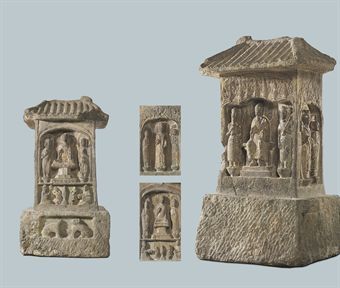A rare dated limestone four-sided Buddhist memorial pillar. Northern Qi dynasty, inscribed with a date corresponding to 574
A rare dated limestone four-sided Buddhist memorial pillar. Northern Qi dynasty, inscribed with a date corresponding to 574, and of the period. Image Christie's Ltd 2009
Three sides carved with niches framing images of Buddha flanked by two standing bodhisattvas, on one side Buddha is seated on a pedestal throne above a cintamani flanked by kneeling figures, with two lions in a panel below, on the reverse Maitreya Buddha is seated on a throne below a draped canopy, with an inscription carved below, on one of the narrow sides Buddha is seated in padmasana, with right hand in abhaya mudra and left hand in bhumisparsa mudra, above another lotus plant and two kneeling figures, on the fourth side a bodhisattva stands between two monks below tree branches, the whole surmounted by a tiled roof. 33¼ in. (84.5 cm.) high - Est. $70,000 - $90,000
Provenance: Tonying & Co., New York, 1962.
Literature: O. Sirén, Chinese Sculpture from the Fifth to the Fourteenth Century, Bangkok, 1998 reprint of 1925 publication, vol. 1, pls. 24 A & B, pp. 55-6.
Saburo Matsubara, Chugoku Bukkyo Chokokushi Ron (The Path of Buddhist Sculpture), vol. 2, Japan, 1995, pls. 464 and 465, where it is dated Northern Qi.
Notes: The inscription may be read: Wu ping wu nian san yue zhong fo dizi Qi Hai/wei fu mu zao si mian shi xiang bao fo zi en, which may be translated, 'During the third month of the fifth year of the reign of Wu Ping (574), the follower of Buddha, Qi Hai, made for his father and mother this four-sided stone sculpture to thank Buddha for his kindness'.
Stone steles of various forms and sizes carved with images of Buddha were popular during the fifth and sixth centuries in China, as a way of venerating Buddha and gaining spiritual favor, not only for those who commissioned them, but also for their ancestors and rulers. These steles depicted Buddha, sometimes in various manifestations, such as Sakyamuni or Maitreya, as well as bodhisattvas, monks, acolytes and donors. They also sometimes depicted the life of Buddha. The depictions chosen often represented the particular deities revered by those who had commissioned the stele. By the Sui and Tang dynasties, the custom of erecting such steles had declined.
Very large steles, either carved on two sides or four-sides, as with the present example, were commissioned by many people and erected in public places and temples. A four-sided stele of this type (146 cm. high) made during the third year of the reign of Wuping (572), from Foshisi, Xunian, Henan, and now in the Henan Provincial Museum, can be seen in a temple courtyard setting in a photograph illustrated by D.C. Wong, Chinese Steles, Honolulu, 2004, p. 148, fig. 9.9. There are twelve niches of figures, and each was dedicated by a large group of donors, which included high-ranking local officials, monks and nuns.
Smaller four-sided steles surmounted by roof-shaped tops, such as the present example, were also commissioned, and include the miniature (41 cm.) pagoda-form example carved with niches of seated Buddhas dated by inscription to 532, illustrated in the catalogue for the exhibition, Return of the Buddha, Royal Academy of Arts, London, 26 April - 14 July 2002, p. 48, fig. 38a. A fragment of another pagoda-form example dated to the Northern Wei dynasty is illustrated in Zhongguo Meishu Quanji: Diaosu Bian, vol. 3, Beijing, 1988, p. 102, no. 84.
Christie's. Fine Chinese Ceramics & Works of Art Including Property from the Arthur M. Sackler Collections. 14 September 2009. New York, Rockefeller Plaza www.christies.com

/https%3A%2F%2Fprofilepics.canalblog.com%2Fprofilepics%2F1%2F0%2F100183.jpg)



/http%3A%2F%2Fstorage.canalblog.com%2F85%2F98%2F119589%2F58416177_p.jpg)
/http%3A%2F%2Fstorage.canalblog.com%2F50%2F17%2F119589%2F57571833_p.jpg)
/http%3A%2F%2Fstorage.canalblog.com%2F04%2F27%2F577050%2F45776434_o.jpg)
/http%3A%2F%2Fstorage.canalblog.com%2F15%2F12%2F119589%2F41979959_p.jpg)